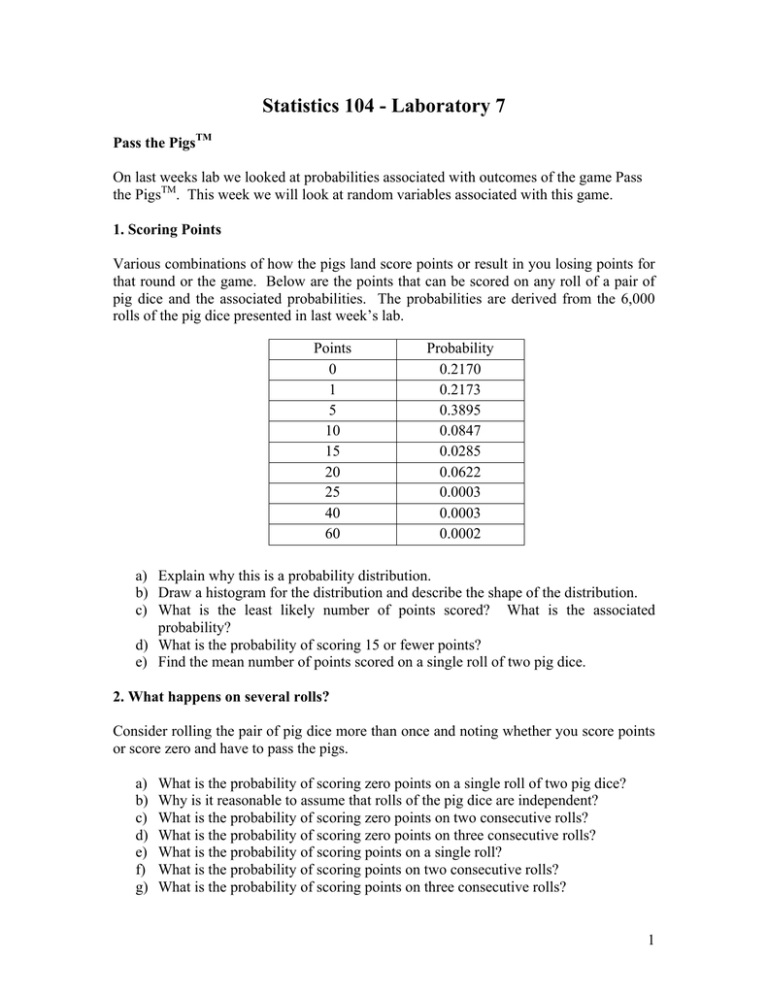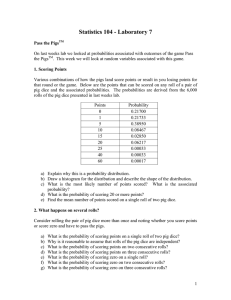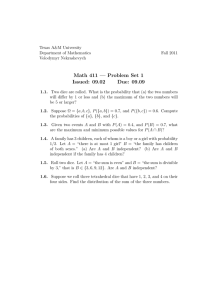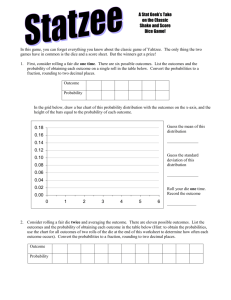Statistics 104 - Laboratory 7
advertisement

Statistics 104 - Laboratory 7 Pass the PigsTM On last weeks lab we looked at probabilities associated with outcomes of the game Pass the PigsTM. This week we will look at random variables associated with this game. 1. Scoring Points Various combinations of how the pigs land score points or result in you losing points for that round or the game. Below are the points that can be scored on any roll of a pair of pig dice and the associated probabilities. The probabilities are derived from the 6,000 rolls of the pig dice presented in last week’s lab. Points 0 1 5 10 15 20 25 40 60 Probability 0.2170 0.2173 0.3895 0.0847 0.0285 0.0622 0.0003 0.0003 0.0002 a) Explain why this is a probability distribution. b) Draw a histogram for the distribution and describe the shape of the distribution. c) What is the least likely number of points scored? What is the associated probability? d) What is the probability of scoring 15 or fewer points? e) Find the mean number of points scored on a single roll of two pig dice. 2. What happens on several rolls? Consider rolling the pair of pig dice more than once and noting whether you score points or score zero and have to pass the pigs. a) b) c) d) e) f) g) What is the probability of scoring zero points on a single roll of two pig dice? Why is it reasonable to assume that rolls of the pig dice are independent? What is the probability of scoring zero points on two consecutive rolls? What is the probability of scoring zero points on three consecutive rolls? What is the probability of scoring points on a single roll? What is the probability of scoring points on two consecutive rolls? What is the probability of scoring points on three consecutive rolls? 1 For 20 rolls of the pig dice, the probability distribution for the number of rolls on which zero points are scored, x, is given below. x 0 1 2 3 4 5 6 P(x) 0.0075 0.0416 0.1095 0.1821 0.2144 0.1902 0.1318 x 7 8 9 10 11 12 13 P(x) 0.0730 0.0329 0.0122 0.0037 0.0009 0.0002 0.0000 x 14 15 16 17 18 19 20 P(x) 0.0000 0.0000 0.0000 0.0000 0.0000 0.0000 0.0000 h) i) j) k) l) m) Explain why this is a probability distribution. Draw a histogram for the distribution and describe the shape of the distribution. What is the probability that you score zero points on all 20 rolls? What is the probability that you score zero points on 6 or fewer rolls? What is the probability that you score zero points on 7 or more rolls? What is the mean of the distribution, i.e. the mean number of rolls on which you score zero points? n) What is the standard deviation of the distribution? 3. Waiting to Pass the PigsTM Another random variable that can arise from consecutive rolls of the pigs is the number of rolls until you pass the pigs, i.e. you score zero points. It is reasonable to assume that consecutive rolls are independent. a) b) c) d) e) f) What is the probability that you pass the pigs after just one roll? What is the probability that you pass the pigs after the second roll? What is the probability that you pass the pigs after the third roll? What is the probability that you pass the pigs after the fourth roll? What is the probability that you pass the pigs after the fifth roll? What pattern do you see in the probabilities? Extra Credit g) Write a general formula for the probability that you pass the pigs after the xth roll. h) Why might it be difficult to find the mean of this random variable? i) The mean of this random variable is 4.608 rolls. Why does this make sense? 2 Statistics 104 - Laboratory 7 Group Answer Sheet Names of Group Members: ____________________, ____________________ ____________________, ____________________ 1. Scoring Points a) Explain why this is a probability distribution. b) Draw a histogram for the distribution and describe the shape of the distribution. c) What is the least likely number of points scored? probability? What is the associated d) What is the probability of scoring 15 or fewer points? e) Find the mean number of points scored on a single roll of two pig dice. 3 2. What happens on several rolls? a) What is the probability of scoring zero points on a single roll of two pig dice? b) Why is it reasonable to assume that rolls of the pig dice are independent? c) What is the probability of scoring zero points on two consecutive rolls? d) What is the probability of scoring zero points on three consecutive rolls? e) What is the probability of scoring points on a single roll of two pig dice? f) What is the probability of scoring points on two consecutive rolls? g) What is the probability of scoring points on three consecutive rolls? h) Explain why this is a probability distribution. i) Draw a histogram for the distribution and describe the shape of the distribution. j) What is the probability that you score zero points on all 20 rolls? k) What is the probability that you score zero points on 6 or fewer rolls? 4 l) What is the probability that you score zero points on 7 or more rolls? m) What is the mean of the distribution, i.e. the mean number of rolls on which you score zero points? n) What is the standard deviation of the distribution? 3. Waiting to Pass the PigsTM a) What is the probability that you pass the pigs after just one roll? b) What is the probability that you pass the pigs after the second roll? c) What is the probability that you pass the pigs after the third roll? d) What is the probability that you have to pass the pigs after the fourth roll? e) What is the probability that you pass the pigs after the fifth roll? f) What pattern do you see in the probabilities? Extra Credit a) Write a general formula for the probability that you pass the pigs after the xth roll. b) Why might it be difficult to find the mean of this random variable? c) The mean of this random variable is 4.608 rolls. Why does this make sense? 5







